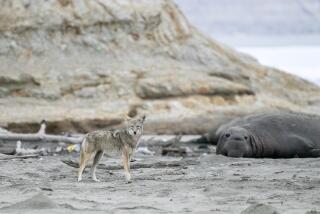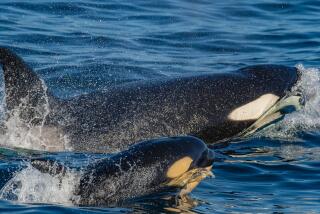007 with a snout? Navy tries to end such scuttlebutt
- Share via
SAN DIEGO — Ten, a 23-year-old bottlenosed dolphin, jumped out of the water and was greeted by her naval colleague with a pat on the snout.
“I love this animal,” Petty Officer 3rd Class Shawn McDonald said.
The brass likes her too. She was part of a contingent of dolphins and sea lions that deployed to the Persian Gulf from 2003 to 2005 to detect mines and underwater saboteurs.
On Thursday, Navy officials allowed a rare glimpse into the training of Ten and the other 74 dolphins and 25 California sea lions at the Navy’s facility on Point Loma. (The Navy’s beluga whale, Ruby, is kept at SeaWorld).
For decades the Navy’s marine mammal program was one of the most secretive programs in the U.S. military. Now the Navy has a website explaining it. Still, rumors persist that the Navy is training the dolphins and sea lions as killers.
“I don’t know how we prove that we’re not doing what we’re not doing,” said Mike Rothe, head of the marine mammal program.
Routinely, the Navy issues such denials and just as routinely the rumors circulate that the mammals are taught how to put explosives beneath enemy ships or drag underwater terrorists to their deaths.
Officials warn reporters not to believe what they may have read in a foreign newspaper or on various websites. And for goodness sakes, they say, don’t buy into the 1973 sci-fi thriller “The Day of the Dolphin,” starring George C. Scott.
The movie posits a nefarious group of big-business types hijacking two talking dolphins to blow up the president of the United States aboard his yacht.
The Navy’s website says flatly: “The Navy does not now train, nor has it ever trained its marine mammals to harm or injure humans in any fashion or to carry weapons to destroy ships.” A light slap is taken at Hollywood: “Fantasy is more interesting than reality.”
A presidential commission in 1990 reported that the dolphins and sea lions are definitely non-combatants.
But when Hurricane Katrina hit the Louisiana coast, a British newspaper reported that Navy killer dolphins had gotten loose and were on the prowl in the gulf.
MSNBC personality Keith Olbermann stopped razzing Bill O’Reilly long enough to have some fun with the idea of dolphins packing poison darts.
The Navy insisted it had no dolphins in Louisiana, but to no avail.
The marine mammal program got its biggest boost during the Cold War. The Soviet navy had its own dolphin program. Neither side wanted to be on the wrong side of a dolphin gap.
Dolphins were used as guards in Cam Rahn Bay during the Vietnam War and in the Persian Gulf during the Iran-Iraq war. Dolphins guarded the bay behind the San Diego Convention Center during the 1996 Republican convention.
In 2003, dolphins and sea lions went to the Persian Gulf in advance of the U.S. invasion of Iraq.
Dolphin lovers sent a protest petition to then Defense Secretary Donald Rumsfeld: “No member of a civilized society should condone the abuse and exploitation of dolphins for military purposes.”
The latest flurry of interest in the marine mammal program came in February, when it was announced that dolphins and sea lions were being considered for use as guards at the Kitsap-Bangor Naval Base in Washington, home to the nation’s largest nuclear arsenal.
At Thursday’s press gathering, reporters were shown a video, given a chance to ask questions of normally press-shy officials, and then watched dolphins and sea lions in their individual holding pens.
One wiseguy, nose to nose with a dolphin, asked the mammal how it liked being in the Navy. The dolphin responded with a squeak.
The dolphin’s physiological sonar is considered better than anything built by a defense contractor. In fact, several years ago the Navy figured that technology would make the dolphins obsolete -- it did not.
The sea lion has great vision in low light, great hearing capability, and can maneuver in tight spots, trainers said.
Both dolphins and sea lions are trained to find a swimmer and then place a clamp on his or her leg and take an attached line to the sailors awaiting above. They also can mark underwater objects.
“It’s their natural environment. They own the water,” Navy Cmdr. Jon Wood said.
Dolphins and sea lions are on duty in the waters off the submarine base in Kings Bay, Ga. Among them is Toad, who is in her late 40s and served in Vietnam.
For Bangor, one plan would have 30 dolphins and sea lions working in shifts to guard the base, where Trident submarines are stationed.
Conservationists oppose the plan. They allege the animals could be harmed by the cold water, an assertion that Navy veterinarians dispute.
Some details remain secret, including how far the mammals can hear and see and how many sailors go with them when they deploy to provide “force protection” for a task force. But on the issue of their duties, officials are unequivocal: It’s mine-detection and swimmer deterrence, and there’s not a Rambo or 007 in the bunch.
“This is us, this is what we do,” psychologist Mark Xitco, head of daily care and training, said as Ten was being taken to her living quarters on San Diego Bay.
More to Read
Sign up for Essential California
The most important California stories and recommendations in your inbox every morning.
You may occasionally receive promotional content from the Los Angeles Times.










